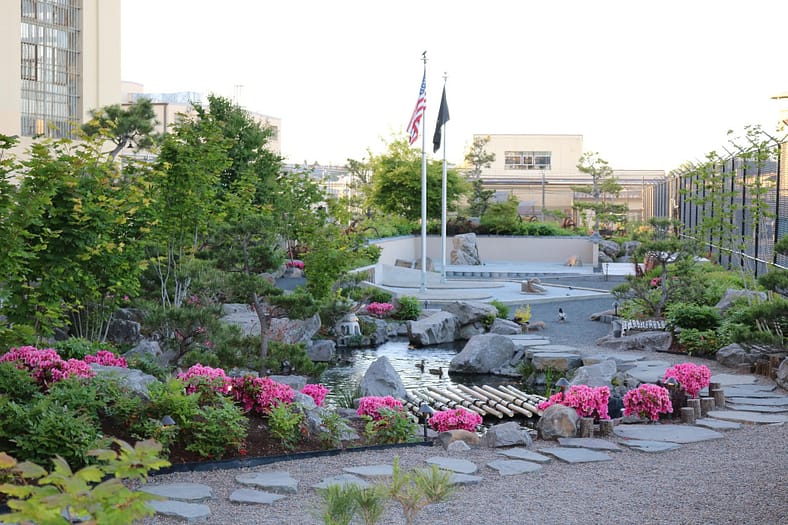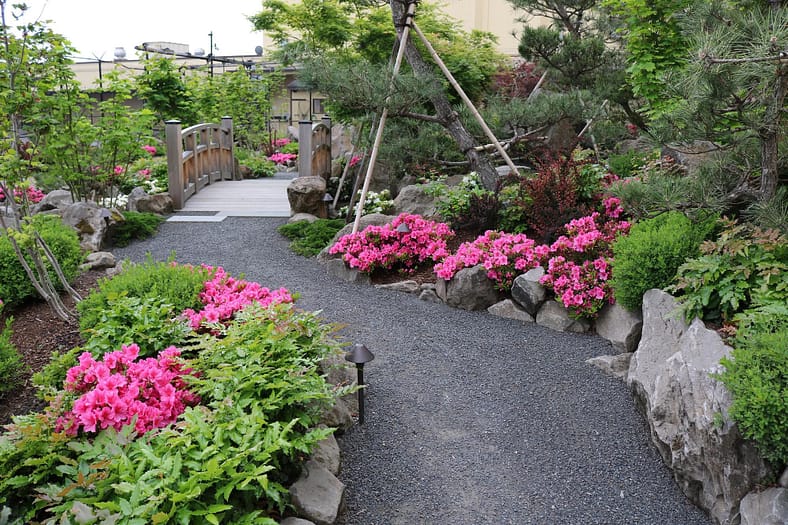
The roads to Oregon State Penitentiary in February are bleak and grow bleaker upon approach. In an unadorned part of the state capital of Salem, brown and gray buildings loom over grassy patches, bare-limbed trees, roads, and parking lots. Even a delicate layer of snow was incapable of masking this area’s inhospitably. It is a radical departure from the serene and verdant landscape that Portland Japanese Garden’s gardeners tend to. And yet, the roads these highly-skilled practitioners took to Oregon’s only maximum security prison led them not to despair, but rather a beating heart healing.
The gardeners were here to see the Memorial Healing Garden, a bastion located on a nearly 13,000-square-foot plot of land in front of Oregon State Penitentiary’s (OSP) cellblock C. Beyond its fences is a prison tableau most would imagine from the popular culture they’ve consumed. Large expanses of asphalt are sectioned off by looming towers and barbed-wire fences. But the Garden itself is an entirely different story. With winding paths, pines, raked gravel, a wooden bridge, and pond filled with koi, it hearkens back to many of the most cherished qualities of Portland Japanese Garden. If you keep your eyeline low, you’re transported.

The Memorial Healing Garden is the product of the planning, fundraising, and volunteer work of 200 adults in custody at Oregon State Penitentiary, in collaboration with 75 community supporters and administrative support from the Oregon Department of Corrections. Established in 2019, over $500,000 in monetary and in-kind donations were privately raised. Similar to how Portland Japanese Garden is not funded with tax dollars, neither was the Memorial Healing Garden. Another connection is that they both feature the work of Hoichi Kurisu, a world-renowned Japanese landscape expert and Portland Japanese Garden’s second Garden Director (1968-73).

“The concept of healing gardens for incarcerated populations is inspirational.” said Hugo Torii, Garden Curator of Portland Japanese Garden. “I wanted the Garden Department to visit this space to gain more perspective on the impact of gardens. Sometimes to be soaked in wilderness provides a reset for humans. Sometimes a single flower on a dining table can give us a similar effect. Gardens provide something in between. While we’re in the midst of the day-to-day maintenance and sustainability of Portland Japanese Garden, I wanted my team to experience this impact on a personal level, away from familiar ground.”
Just how Portland Japanese Garden’s grounds are maintained through a combination of longtime practitioners and beginners, the Memorial Healing Garden was created through a combination of experts and newcomers: Kurisu and the adults in custody who have joined and lead OSP’s Asian Pacific Family Club (APFC).
Sometimes to be soaked in wilderness provides a reset for humans. Sometimes a single flower on a dining table can give us a similar effect.
Hugo Torii, Garden Curator
“The beginning stages of the concept required a lot of research, community building, hard work and dedication,” writes current APFC President Jimmy Kashi. “We read books on how to build gardens, ponds, and koi care. Also, we called businesses to get quotes on cost, logistics and to learn exactly what it would entail to get our idea off the ground.” The diligent work of the APFC has not slowed since the Garden opened in 2019.
“I knew what to expect because I had had done research before going,” offered Senior Gardener Jason Wiley. “However, what you cannot get by research is the feeling of emotion when the adults in custody talk about how much the garden has impacted their lives and how it has brought segregated groups together for one purpose. The fact that these guys can work in the garden is encouraging for them to work toward a common goal and to think about this as a life lesson in general.”

A key figure in the construction of the Memorial Healing Garden and someone who knows full well the impact it can have is Toshio Takanobu, former President of the APFC and an individual whose sentence was commuted by former Oregon Governor Kate Brown. Governor Brown specifically referenced his work in the garden when explaining her decision, writing, “Mr. Takanobu demonstrated excellent progress and extraordinary evidence of rehabilitation, including furthering his education, participating in a youth speaking panel, engaging in treatment, building programming in OSP and helping to spearhead the construction of the memorial healing garden within OSP.”
The Memorial Healing Garden is something Takanobu says not only transformed his life, but the life of his friends and colleagues at OSP. “Before we had a space of healing, there was no place for people who were dealing with family passing. People weren’t able to deal with the trauma and depression of loss. They resorted to drugs, violence, or potentially, self-harm. The garden has been able to created a place for peace for people to decompress or reflect in a manner that’s healing them in this process. With one client in particular, he had delayed development and trauma and then tragically, his mother passed away.”

“We asked this mentee to pick a plant that we would plant in honor of his mom,” Takanobu continued, “He put the plant up on the hill behind the Zen garden. The APFC team, his counselors, the security staff, all stood there in solidarity with this individual to let him know that he has support. The Healing Garden has transformed him. He kept himself in his room and never left but now he’s out and about and has an industry job. He programs himself. He fulfills his responsibilities and treats people with respect. And that’s all because of [the Memorial Healing Garden].”
A space like this leads some to question whether something beautiful should exist for people sentenced to reside in a maximum-security prison. The penitentiary’s staff has noted in the past that approximately 95 percent of the adults in custody at Oregon State Penitentiary will be released and rejoin society. The Memorial Healing Garden can be then seen to be more than just a name, it’s an intention. The harshness of concrete and steel is a hostile environment that curtails rehabilitation; the garden is a balm that soothes.
The harshness of concrete and steel is a hostile environment that curtails rehabilitation; the garden is a balm that soothes.
Where better to spread the sensation of peace than an institution seeking to reform its charges? Just as Portland Japanese Garden has provided the space for people to reflect and reorient, so does the Memorial Healing Garden. Randy Guzek, Memorial Healing Garden Director, writes, “The life-guiding metaphors represented in each of the features making up the Healing Garden contribute to motivation, cultivation, restoration, and growth. There is something infinitely healing in these understandings, something that becomes even more profound as we share them with others.”

In a paper by Western Oregon University Professor Miyuki Airomoto and Willamette University Professor Melissa Buis Michaux, they note that the OSP garden is the deployment of transformative justice, an evolutionary approach of corrections with five “fundamental insights”:
- Affirmation of the worth and dignity of every human
- Demand for accountability for harms generated
- Inviting a variety of participants into their work develop a sense of community
- Creating opportunities for offenders to make amends
- Repairing harm in relationships and changing systems that cause harm
“The overall experience [at OSP] and especially at the Healing Garden made me recognize more about humility and value community and understand how to be in service—helping others while also helping yourself,” Takanobu shared while discussing his future. “I’m pursuing certification in welding to add more skills and maybe potentially I can utilize these skills in creating sculptures that aligns with Japanese gardens. The other thing that I’m doing is I’m enrolled in a certified recovery mentor specialist program. They will give me certification credentials to be a ‘peer support mentor.’ Those past three years at OSP that’s all we have been learning to do—utilizing the Healing Garden as peer support, helping guys from mental health units and the ones transitioning to the general population.”

The gardeners who made this visit feel very strongly that a garden can help heal.
“Healing is a personal and communal endeavor, which requires attention, care, and openness,” offered Caleb Hendrickson, one of the gardeners who made the visit and had visited twice before. “Safe environments that ask for our mutual care and appreciation are vital to weather the challenging and dangerous spaces we navigate every day. Nurture and nature together offer opportunities for health.”
“Being connected to nature heals us,” reflects Torii. “I hope to continue to explore and experience the potential of gardens and garden spaces for years to come.”
“Safe environments that ask for our mutual care and appreciation are vital to weather the challenging and dangerous spaces we navigate every day. Nurture and nature together offer opportunities for health.”
Caleb Hendrickson, gardener